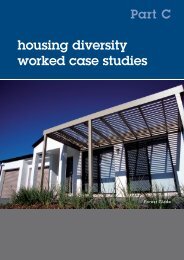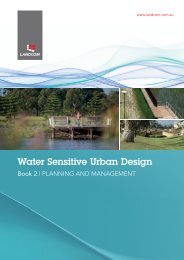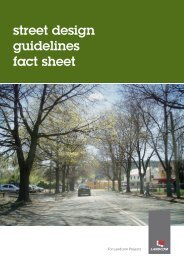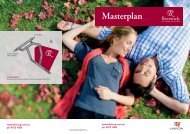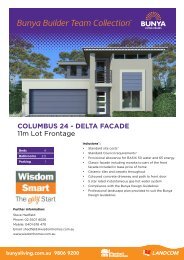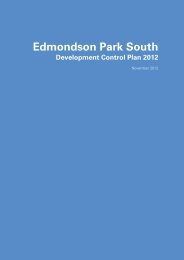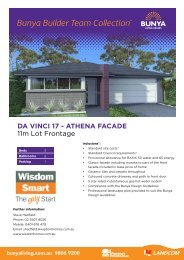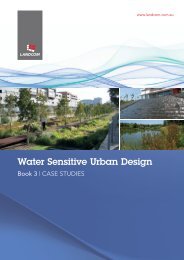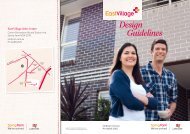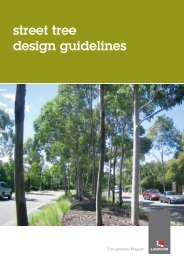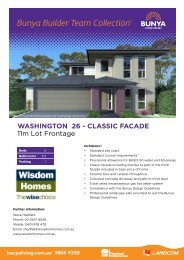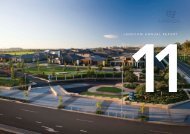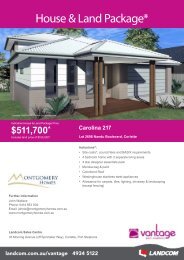open space design guidelines fact sheet - Landcom
open space design guidelines fact sheet - Landcom
open space design guidelines fact sheet - Landcom
Create successful ePaper yourself
Turn your PDF publications into a flip-book with our unique Google optimized e-Paper software.
<strong>open</strong> <strong>space</strong><br />
<strong>design</strong> <strong>guidelines</strong><br />
<strong>fact</strong> <strong>sheet</strong><br />
For <strong>Landcom</strong> Projects
1 | Open Space Design Guidelines FACT SHEET<br />
Open Space Design Guidelines<br />
Fact Sheet<br />
A growing body of research from around the world is adding weight to what most<br />
of us have intuitively believed: that our parks and <strong>open</strong> <strong>space</strong>s are good for us. But<br />
what is also emerging from this research is that the quality of <strong>design</strong> of our public<br />
<strong>open</strong> <strong>space</strong>s has a direct bearing on how often we use these <strong>space</strong>s, how safe we<br />
feel when we are there and what level of enjoyment and wellbeing we gain from the<br />
experience.<br />
About the <strong>guidelines</strong><br />
As a government agency with responsibility for<br />
delivering sustainable communities, <strong>Landcom</strong><br />
is aware of the critical role that public <strong>open</strong><br />
<strong>space</strong> plays in developing and nurturing those<br />
communities. The Open Space Design Guidelines<br />
have been developed to help deliver the best<br />
possible outcomes for <strong>open</strong> <strong>space</strong>. The results, we<br />
hope, will be places that are much loved, well used<br />
and greatly enjoyed.<br />
The objectives of the <strong>guidelines</strong> are:<br />
• To demonstrate our commitment to best<br />
practice in <strong>open</strong> <strong>space</strong> planning and <strong>design</strong>.<br />
• To engender shared values within <strong>Landcom</strong> as<br />
to what defines best practice in <strong>open</strong> <strong>space</strong><br />
<strong>design</strong> and delivery.<br />
• To demonstrate a consistent, accountable and<br />
transparent process for <strong>open</strong> <strong>space</strong> <strong>design</strong>,<br />
delivery, management, maintenance and<br />
handover to all of our partners and stakeholders<br />
in that process.<br />
• To provide a framework upon which more<br />
detailed <strong>design</strong> and delivery processes can be<br />
built.<br />
The scope of<br />
the <strong>guidelines</strong><br />
Riparian Corridors and<br />
Bushland Settings<br />
These <strong>guidelines</strong> focus on the typical forms of public<br />
<strong>open</strong> <strong>space</strong> for which <strong>Landcom</strong> is responsible for<br />
delivery through its development projects. These<br />
include parks ranging in size from 0.5 to 2 Ha or<br />
more, and corridor <strong>open</strong> <strong>space</strong>s often associated<br />
with creeks, rivers and foreshores, or bushland with<br />
a focus on pedestrian and cycle paths in a setting of<br />
linked <strong>open</strong> <strong>space</strong>s.<br />
Larger parks (up to several hectares)<br />
incorporating facilities such as<br />
sports fields and courts<br />
Smaller parks from 0.5 up to 1 Ha<br />
mostly focused on passive<br />
recreation uses<br />
Some typical public <strong>open</strong> <strong>space</strong> settings.<br />
Corner Parks or Playgrounds<br />
usually inner urban<br />
infill sites only
Open Space Design Guidelines FACT SHEET | 2<br />
Key principles<br />
The <strong>guidelines</strong> include key principles upon which<br />
<strong>open</strong> <strong>space</strong> is to be <strong>design</strong>ed, delivered and<br />
managed. These include:<br />
1. Be meaningful to place and community<br />
2. Be multi-functional and adaptable<br />
3. Provide diversity<br />
4. Encourage social interaction<br />
5. Promote health and wellbeing<br />
6. Provide equity and accessibility<br />
Public <strong>open</strong> <strong>space</strong>s should provide opportunity for informal<br />
physical activity for children, especially within residential areas<br />
where private gardens are small or non-existent. Photo - Forest<br />
Glade<br />
7. Embody environmental sustainability<br />
8. Ensure financial sustainability<br />
The document also includes <strong>guidelines</strong> for:<br />
Design and delivery – objectives for a successful<br />
delivery program from <strong>design</strong> and documentation<br />
to final handover to the end owner.<br />
Ownership and maintenance handover –<br />
objectives and processes that will assist a<br />
smooth handover of ownership and long term<br />
maintenance.<br />
Checklists are also provided to establish delivery<br />
processes and <strong>design</strong> principles are being met as<br />
a project progresses.<br />
Major public <strong>open</strong> <strong>space</strong>s set the social and recreational<br />
framework for new communities. Their <strong>design</strong> and delivery<br />
must receive the widest support if they are to be successful<br />
places. Photo - Park Central.<br />
Victoria Park
3 | Open Space Design Guidelines FACT SHEET<br />
Macarthur Gardens<br />
Contacts<br />
For further industry enquiries about this guideline contact<br />
Anna Petersen<br />
<strong>Landcom</strong> Social Sustainability Manager<br />
apetersen@landcom.nsw.gov.au<br />
02 9841 8652<br />
Steve Driscoll<br />
<strong>Landcom</strong> Director Sustainability & Policy<br />
sdriscoll@landcom.nsw.gov.au<br />
02 9841 8693<br />
For all media enquiries about this guideline contact<br />
Suzanne Davies<br />
<strong>Landcom</strong> Media and<br />
Government Relations Manager<br />
sdavies@landcom.nsw.gov.au<br />
02 9841 8788 or 0439 439 107



